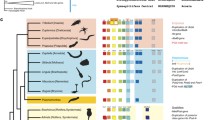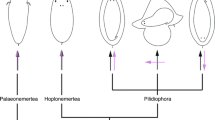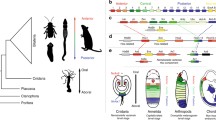Abstract
In recent years the characterization of Hox genes in different phyla has led to the suggestion of a universal role for these genes in animal axis determination. Some phyla, such as Platyhelminthes, have not yielded easily to such analysis, although a range of Hox genes have been shown to be present. In this report we present data concerning the relatively large number of Hox genes with a close similarity to representatives of annelids, supporting a phylogenetic clustering of Platyhelminthes within the spiralian protostomes. We also point out the permanent presence of Hox transcripts in adult planarians, with two classes distinguishable by their different patterns of axial expression: some are expressed uniformly, whilst a second group shows a nested expression with graded anterior expression boundaries. During posterior regeneration the nested Hox genes increase differentially depending on the level of sectioning, and then turn on gradually to recover the differential axial pattern of intact adults. These molecular results and others at the cellular level support the previous hypothesis that Platyhelminthes may have become simplified by progenesis.
Similar content being viewed by others
Author information
Authors and Affiliations
Additional information
Received: 6 April 1998 / Accepted: 5 June 1998
Rights and permissions
About this article
Cite this article
Bayascas, J., Castillo, E. & Saló, E. Platyhelminthes have a Hox code differentially activated during regeneration, with genes closely related to those of spiralian protostomes. Dev Gene Evol 208, 467–473 (1998). https://doi.org/10.1007/s004270050204
Issue Date:
DOI: https://doi.org/10.1007/s004270050204




